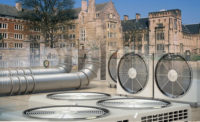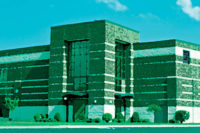With a modern façade, energy-efficient MEP systems, and an artistic interior staircase, the new campus building at 41 Cooper Square is a case in point for a student body that majors in architecture, engineering, and the arts.
At the heart of Manhattan’s East Village, the nine-story, 175,000-sq-ft building sticks out in both size and shape from its historic neighbors. As the new gathering place and the central campus building for New York City’s Cooper Union for the Advancement of Science and Art, 41 Cooper Square hosts state-of-the-art academic laboratories, studios, classrooms, science, and research spaces. However, arguably the most important lessons learned at 41 Cooper Square are those gained behind the walls and public spaces where teams of building professionals designed and successfully built New York City’s first LEED® Platinum academic laboratory facility.
Through a number of energy-efficiency strategies including radiant heating and cooling, demand control ventilation, heat recovery, a high-performance façade, occupancy sensors, control strategies, and more, 41 Cooper Square is almost 40% more efficient than standard buildings in its class. Designed by Syska Hennessy Group (New York) in collaboration with IBE Consulting Engineers (Los Angeles), the building’s MEP infrastructure met and currently exceeds the College’s performance goals.
With a high prescription for occupant comfort and efficient MEP systems design, a number of state-of-the-art building technologies were specified at 41 Cooper Square. Through energy modeling and creative engineering, different HVAC scenarios were tried and tested until the right formula for the building emerged.
RADIANT HEATING AND COOLING
Typical MEP systems strive to maintain the thermal comfort of a given space by regulating temperature, humidity, and air movement. Radiant systems present a fourth aspect of comfort: mean radiant temperature. Traveling through a designated space, radiant panels filled with hot or cold water heat or cool an object of the opposite temperature. The warmer object radiates heat to the cooler object, or the cooler object absorbs heat from the warmer object. The human body perceives this heat transfer as more comfortable than other heat transfers (convection and conduction).
After an energy model suggested significant savings would result, both radiant ceilings and floors were employed at 41 Cooper Square. Radiant ceilings are used in approximately 80% of the building, including classrooms, offices, and laboratories, while radiant flooring is employed in the main lobby (heating only), the first floor multipurpose room, and the three-story-high gallery exhibit area.
Due to its decoupling of hydronic conditioning from ventilation application, radiant heating and cooling provided design engineers with the significantly improved HVAC efficiencies they desired. With the exception of the art studio spaces on ninth floor and subcellar laboratories, 41 Cooper Square is exclusively serviced by radiant heating and cooling, which reduces airflow to these spaces by as much as 35%. Due to high air-change rates, laboratories are provided with heating-only radiant panels.
When implementing the radiant heating and cooling, the engineering design team took great care to avoid condensation. Because of New York’s variable climate and in the interest of maintaining the optimal IAQ and thermal comfort for the building, avoiding condensation took on a two-tiered approach: to prevent it and, if condensation does occur, to control it.
In an effort to prevent condensation, operable windows once considered for 41 Cooper Square were eliminated from the design, and latent heat from the building is removed through dedicated 100% outside air units. Chilled water supply temperature to the ceiling panels is maintained in each room to at least 2ºF above the space dewpoint, effectively eliminating the opportunity for water to condense.
Designing the building to maintain a slightly higher temperature of 78ºin the summer, the radiant panels actually help bodies in this warmer temperature feel cooler. Through dedicated heat exchangers, the radiant panels themselves are set to a surface temperature of 59º(dew-point 57º), with a supply chilled water temperature of 55ºand return supply temperate of 63º. In wintertime, the hot water supply temperature to the panels varies from 100ºto 140º, depending on the outside air reset temperature.
In an effort to control any condensation that might occur, an extensive control sequence was developed and implemented. If a radiant pipe serving a single room senses condensation via the pipe-mounted moisture detector, the chilled water control valve will close on that room and the maintenance or facilities engineer will be automatically alerted through the BMS to investigate.
If condensation were to occur in multiple spaces, the radiant system in those spaces would be shut off as well. In this scenario, the temperature of the water in the rest of the building would be increased by 2º. Within 15 minutes of the initial condensation occurring, the BMS changes the chilled water temperature to increase by another 2º. After this, if condensation is still present, the entire radiant system would shut off. After 30 minutes of no condensation detected, the water temperature would begin to decrease by 1ºevery 15 minutes, going back to normal in 1ºincrements.
Classrooms and offices are conditioned by a hybrid system consisting of a radiant ceiling for both heating and cooling and a VAV system. Temperature control in these spaces is indexed via the BMS automatically and heating or cooling is provided as needed. Detection of personnel in these areas through occupancy sensors is also indexed via BMS and ventilation provided through VAV boxes. The system decouples the loads in most spaces, the radiant ceiling providing heating and cooling and the VAV system providing ventilation and latent cooling. In certain spaces, if additional cooling is required after the radiant panel system employs its full capacity, the air system supplies the capacity in excess of minimum ventilation.
The radiant heating and cooling system also furthered the architectural vision for the space. Without the need for large ceiling ductwork, the radiant system permitted 10-ft-high ceilings on each of the nine floors, capping the building at 135 ft, which is the maximum allowable by area zoning laws. With just 2.5-ft ceiling plenums on each floor, the desired industrial look was maintained.
AIRSIDE ENERGY RECOVERY
All classrooms and offices are provided with 100% outside air filtered by the building’s AHUs. This outside airflow enters occupied offices and classrooms and is transferred from these spaces through each floor’s corridor into the atrium, where it is returned at the top. From here, the air is recovered and sent to laboratory air handling units to be recirculated. This is known as a cascading air system.
Requiring eight to 12 (and in some spaces even more) air changes per hour (ach), lab spaces demand large air volume. In order to meet this need, and simultaneously minimize the additional energy costs associated with it, the labs at 41 Cooper Square receive partial outside air and partial returned air from offices and classrooms. Not all air that leaves the atrium can be recirculated for laboratories. Whether the air is appropriate or not for the lab spaces is determined by the specific laboratory air demands and return air temperature. As a result, in the summer less air is recovered for the lab spaces; conversely, in the winter more air is sent to the laboratories. All air leaving the lab is exhausted into the atmosphere by a lab exhaust fan system.
DEMAND CONTROL VENTILATION
Airflow monitoring stations located at the AHUs, combined with CO2 sensors in the building’s densely occupied spaces of more than 40 sq ft/person (e.g., classrooms, offices, and the auditorium) provide another opportunity to minimize energy expenditure. Working together, the airflow monitoring units and the CO2 sensors integrated through the building’s BMS monitor and deliver the amount of ventilation air flow needed in each space.
For example, when a room is full and the CO2 level rises above the outdoor level by 650 ppm (adjustable per ASHRAE Standard 62, Appendix C) in the space, the sensor notifies the airflow monitoring station to increase the outside air in the space.
Conversely, when occupancy drops and less CO2 is detected in the space, outside air is decreased. While the sensors have no way of determining the actual amount of people in the space, working hand-in-hand with the building’s VAV system, they have the ability to manage outside air quantities as needed. By supplying only the amount of outside and conditioned air that is needed in each space, IAQ is maintained and energy consumption and cost is reduced.
VAV
The building’s VAV system is crucial to the success of each of the above-mentioned mechanical systems. Helping each one to meet only the current demand of a given space and not over cool or heat any area, the VAV system ensures operational efficiency.
Additionally, the laboratories at 41 Cooper Square contain high-efficiency VAV fume-hoods with adjustable sash positions, which allow for a lower than normal face velocity. These hoods help reduce energy consumption by as much as one-third each over conventional fume hoods.
While 41 Cooper Union opened in late 2009, it recently installed a measurement and verification system set to monitor the building’s electrical power, chilled water, air, and gas consumption as well as total energy use. Installed as an extension of the building’s BMS, a separate M&V server tracks all data and stores it for years to come. ES
|
More Green Initiatives Beyond efficient mechanical systems design, 41 Cooper Square is an archetype of sustainable successes. From its green roof with a storm water retention system to a one-of-a-kind efficient building envelope that provides solar energy screening for natural daylighting, 41 Cooper Square is the first LEED® Platinum academic laboratory in New York City. The building’s green roof reduces the urban heat island effect and therefore lowers energy consumption in the spaces below. Additionally, the building contains a rainwater harvesting tank that is used for storm water retention, capturing water runoff to reduce the flow of storm water into the New York City sewers and serving as its as green roofs irrigation source. No potable water is used for irrigation. When the roof tank reaches capacity, water overflows to a second tank on the second floor, where it is repurposed in the building’s below-grade toilet fix-tures. The building’s unique double-wall façade is made up of a high-performance, 50% perforated stainless steel skin wrapped around a glazed envelope. Acting as a barrier for both heat gain and loss to the envelope, the metal skin reduces required equipment capacities for cooling and heating that minimize both operational expenditure and upfront capital costs. Additionally, the project team developed control strategies for the skin’s operable panels and worked on integrating panel power supplies and controls into the building’s BMS, controlling the amount of daylight that enters the building. Occupancy and motion sensors are tied into the building’s lighting and HVAC systems. Programmed to gradually turn off when no occupancy is detected or when scheduled to by the BMS, sensors are located in the offices, classrooms, research spaces, and laboratories where they will turn the systems down to unoccupied mode. Laboratory exhaust and ventilation air is turned down to a minimum position, even in unoccupied mode. The BMS has been programmed with override capabilities as well. |
|
Studying Radiant Technology Radiant heating and cooling is not a new technology. From an ancient technology to the 1940s and 1950s, radiant heating and cooling has traditionally been employed unsuccessfully as a result of poor performance, unsophisticated controls, and an industry that lacked a real understanding of how it should be employed. In order to specify radiant heating and cooling for 41 Cooper Square, Syska Hennessy and IBE would have to prove to The Cooper Union that their concerns about condensation control and reliability were not an issue. Traveling to Europe, building team members from Syska Hennessy, IBE, and The Cooper Union toured existing installations, gathering lessons learned and tips on how to avoid condensation. |









